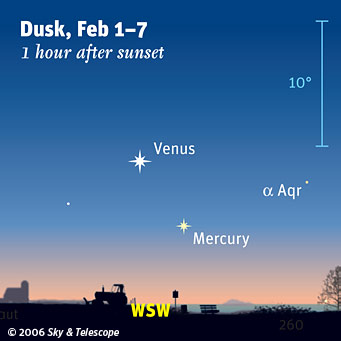
You can catch the two innermost planets of the solar system on any clear evening this week. They're much more different in brightness than indicated here. Look too early and Mercury will be invisible; look too late and it will have set! (The blue 10° scale is about the size of your fist at arm's length.)
Sky & Telescope diagram.
Throughout the next several days, evening twilight will host a pair of bright planets. Brilliant Venus has been gradually climbing out of dusk since the end of 2006, and will remain an "Evening Star" until July. The planet shines at magnitude –3.9 in the west-southwest.
Tonight Venus is 15 times brighter than innermost planet Mercury (magnitude –1), which is making a quick dash to join Venus. The two will be closest on February 4th, lying about 6° apart. Mercury will slowly fade as it climbs highest above the horizon and reaches its farthest from the Sun — called greatest elongation — on February 7th. A week later, Mercury will have returned to deep twilight. It will be in the morning sky during March and April and back visible during evening in May.
Bring out your telescope to watch the changing phase of Mercury and you could glimpse a bonus planet! Uranus will lie two-thirds of a degree to the right of Venus on February 7th. Wait for twilight to darken to try to spot the seventh planet at a mere magnitude 5.9. Venus is nearly 10,000 times brighter, with Uranus about 14 times farther away.
 0
0
Comments
You must be logged in to post a comment.